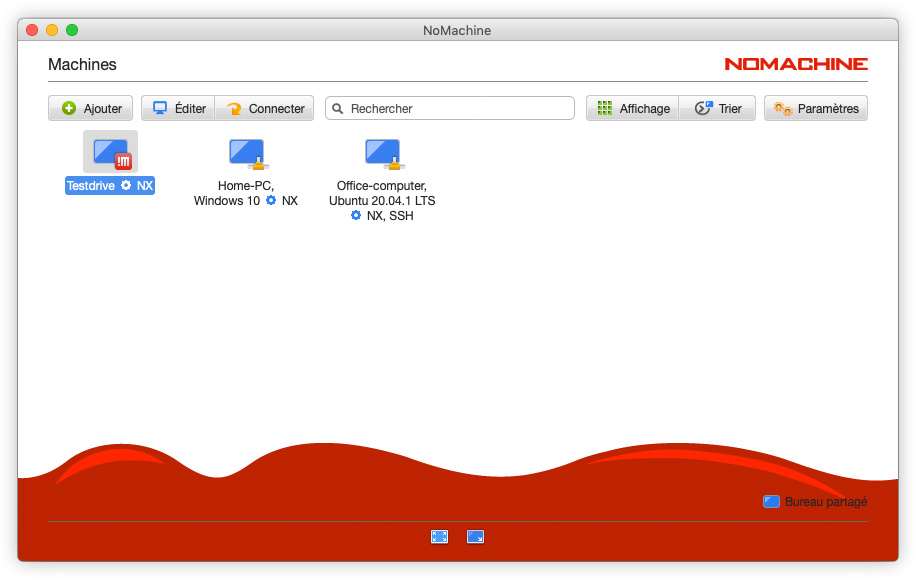

Select the protocol you want to use to connect to your remote machines. To create a new connection, you can click any of the areas highlighted in the screenshot below. Since this is a new installation, you will such a screen. From the interface that opens up, you will see some guidelines on using NoMachine.Ĭlick Continue from the screen above to view NoMachine recent connections, open recent connections or create new connections. Launch NoMachine from the activities tap. For example, on RHEL based systems, you would simply open the NoMachine TCP and UDP ports by running the command below firewall-cmd -add-port=4000/tcp -add-port=4011-4999/udp -permanent firewall-cmd -reload Create NoMachine Connections on CentOS 8
#Nomachine unr how to#
Read more on Default ports used by NoMachine 4 or later.Ĭonsult your respective system documentation on how to open ports on firewall. There are other ports like 40 for web connections. In order to be able to connect to your desktop via NoMachine from a remote machine, you need to open some ports on firewall preferably port 4000/TCP, 4011-4999/UDP (mostly for transmitting video and audio streams). It enables you to check server status, connected users, active transfers, NoMachine Server preferences, restart, stop or shutdown NoMachine server. NoMachine service manager is a small application which gives you access to server NoMachine management tools and User Interface and advises you when someone is requesting to connect. You should see NoMachine and NoMachine service manager. Once NoMachine is installed, you can be able to launch it from the activities tab at the top left corner. NX> 700 NoMachine was configured to run the following services:Ĭomplete! Setup NoMachine for Remote Connections NX> 700 Creating configuration in: /usr/NX/etc/server.cfg. NX> 700 Installing: nxserver version: 6.9.2.

NX> 700 Creating configuration in: /usr/NX/etc/node.cfg. NX> 700 Installing: nxnode version: 6.9.2. NX> 700 the user account must be a member of the CUPS System Group: sys. NX> 700 To connect the remote printer to the local desktop, NX> 700 Installing: nxplayer version: 6.9.2.
#Nomachine unr install#
NX> 700 Install log is: /usr/NX/var/log/nxinstall.log. NX> 700 Using installation profile: Red Hat. NX> 700 Installing: nxclient version: 6.9.2. Package Architecture Version Repository Size Well, if your system has direct internet access, you would simply run the installation of NoMachine on CentOS 8 by executing the command dnf install nomachine_6.9.2_1_x86_64.rpm 1.4 MB/s | 45 MB 00:31 Once you have downloaded the RPM binary installer, you can simply install it as follows dnf install nomachine_6.9.2_1_x86_64.rpm You can simply grab the link and pull it using the wget command.
#Nomachine unr software#
I really want to like the software and service but I simply cannot understand why NM is even still a thing when (for example) the Anydesk offering is free, is easier to configure, doesn't need the prospect of port forwarding and works well though is a bit crap for business environments).Choose the installer for you respective system architecture and download it. Logging in - As far as I can tell I would need to create a hidden admin user on MS and Apple machines so that the end-user sees "PC Support" just connected rather than their own username. Ports - Seriously in this day and age you still need to forward ports on some routers to be able to use NM? Can someone please explain is idiot-proof terms the differences?
#Nomachine unr free#
What is the difference between the free version and the Enterprise Desktop version? To me, there is no difference at all. I've toyed with NM in the past and like what I see but why do they make it so damn difficult to use?įirst off, the different packages. I am an MSP / remote support engineer with one employee (me) and about 300 endpoints (a mix of Microsoft and Apple) currently using a combination of Atera, free Splashtop via Atera, Teamviewer (rolling out) and AnyDesk (replacing with TV).


 0 kommentar(er)
0 kommentar(er)
